Last Updated on July 11, 2022 by Constitutional Militia
“Militia”: Defined by Law
WE THE PEOPLE in 1791 did not need to consult isolated statements of various Framers and Founding Fathers in order to ascertain with exactitude the defining constitutional principles of “[a] well regulated Militia”. Neither do WE THE PEOPLE today. These were not merely theoretical “Militia”, but instead were actual institutions—the only institutions of their kind—which existed in 1788 and had existed theretofore for generations throughout America, settled and regulated pursuant to Colonial and then State statutes.
“Militia” were and remain legally defined by the statutes that addressed them in great detail for over 150 years prior to the ratification of the Constitution
Is it conceivable that WE THE PEOPLE in 1791 could have considered undefinable the very “well regulated Militia” which they explicitly identified as “necessary to the security of a free State”? Or that they would have left that phrase entirely undefined, and therefore subject to the vagaries of ever-changing definitions by Congress, the States, or the Supreme Court, as the mere ignorance, political intrigues, or even subversive designs of incompetent or malign public officials and special-interest groups might dictate? Not at all. For THE PEOPLE knew that
“[t]he very purpose of a Bill of Rights [is] to withdraw certain subjects from the vicissitudes of political controversy, to place them beyond the reach of majorities and officials and to establish them as legal principles * * * . One’s * * * fundamental rights may not be submitted to vote; they depend on the outcome of no elections.”[1]
It is inconceivable that what WE THE PEOPLE declared to be “necessary to the security of a free State” in the Second Amendment in 1791 was undefinable. A “well regulated Militia” is no mere philosophy debate for modern day ivory-tower intellectuals, nor a playpen of conjecture for self-styled “experts”, but a conclusion in which WE THE PEOPLE in 1788 and 1791 undoubtedly concurred. When THE PEOPLE incorporated “the Militia of the several States” into their new Constitution’s federal system, they knew full well that these were statutory institutions already in existence, separate in every State and each one the creature of its own State’s laws. When THE PEOPLE referred to “[a] well regulated Militia” in the Second Amendment, they knew exactly what the salient principles of “regulat[ion]” were, because those principles could be found, repeated again and again, in statute after statute the Colonies and then the independent States had enacted throughout the 1600s and 1700s. See for instance Rhode Island and Virginia regulating their Militia. And when THE PEOPLE authorized Congress “[t]o provide for organizing, arming, and disciplining, the Militia”,[2] they knew to the last detail what those activities entailed, because they were familiar with the “well regulated Militia” the Colonies’ and States’ statutes had produced in the past.
Militia Structures existed at all times, in war and peace, as a matter of fact and law evidenced by the countless Militia statutes that addressed them in great detail in every one of the Colonies, and then independent States from the early 1600s. “Militia” in the American legal lexicon means the entirety of the able-bodied adult population, properly organized, armed, and disciplined pursuant to statute in some effective manner at all times. This ties in directly with Congress’s constitutional power and duty “[t]o provide for organizing, arming, and disciplining, the Militia”. By incorporating “the Militia of the several States” into its federal structure, the Constitution ensures that such “Militia”—and, absent an Amendment, only such “Militia”—will always exist under its aegis. For the very good reason that, as the Second Amendment attests, such “well regulated Militia” are “necessary to the security of a free State”, and therefore the very foundation of the constitutional system.[3]
During the entire pre-constitutional period, the common meanings of what became the constitutional phrases “Militia of the several States”,[4] “organizing, arming, and disciplining, the Militia”,[5] “[a] well regulated Militia”, and “the right of the people to keep and bear Arms”[6] were their “technical” meanings, because the “Militia” that existed in that era were not some theoretical “militia”, but instead the particular “Militia” that were formed and operated under the aegis of these statutes. The “technical” meanings of all these phrases were defined initially in the statutes; and from these “technical” meanings the common meanings derived through Americans’ actual experiences as the statutes were applied.[7]
“[W]ell regulated Militia”—were the products of statutes which Americans had believed were so effective in achieving their ends that they had enacted them and reënacted them and reënacted them yet again, in form and substance, decade after decade and generation after generation.
Terms in the original Constitution and the Bill of Rights employed in 1788 and 1791 mean today precisely what they meant then. That the Constitution “speaks not only in the same words, but with the same meaning and intent with which it spoke when it came from the hands of its framers”[8] applies to the specifically legal meaning its words and phrases had in that day: “The scope and effect of * * * many * * * provisions of the Constitution[ ] are best ascertained by bearing in mind what the law was before.”[9] “We are bound to interpret the Constitution in the light of the law as it existed at the time it was adopted[.]”[10] “[O]ur inquiry concerns the [legal] standard prevailing at the time of the adoption of the Constitution, not a score or more years later”.[11] Moreover, “[t]he law as expounded for centuries cannot be set aside or disregarded because some of the judges”—or legislators, or factions and special-interest groups, or members of the intelligentsia—“are now of a different opinion from those who, [two] centur[ies] ago, followed it in framing our Constitution”.[12] Indeed, it is even more ridiculous to suggest that the law upon which the Constitution was based may be “reinterpreted” today than that the Constitution’s words may be.





























